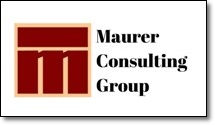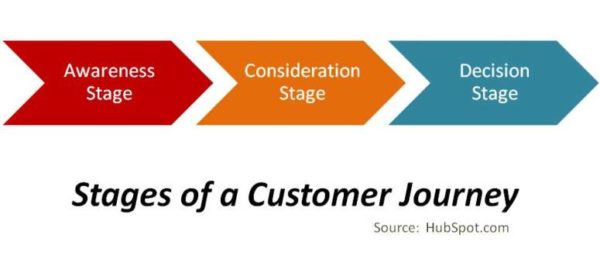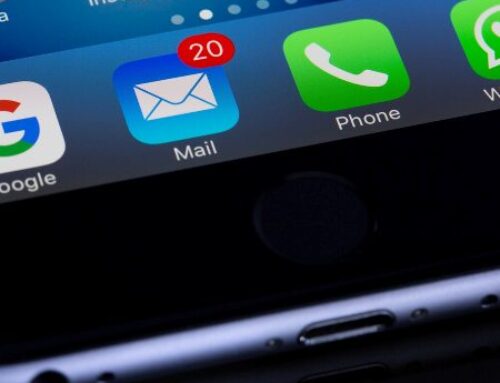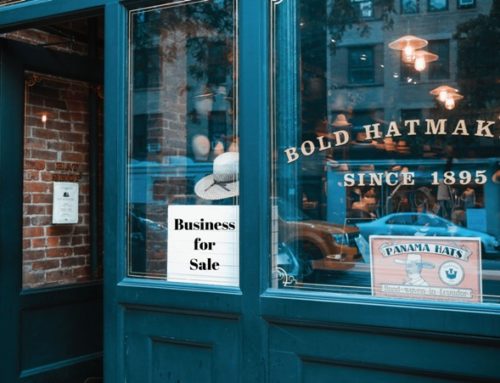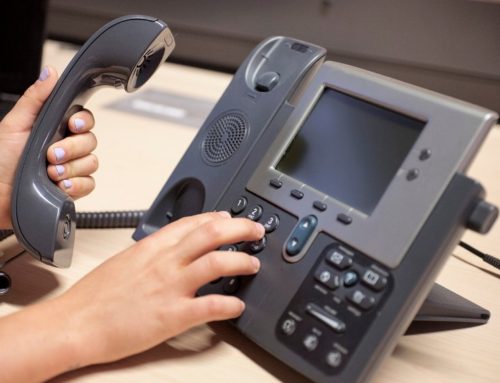Efficient Marketing Through a Customer’s Buying Journey
Prospects find their way to your website for different reasons. Not only for different reasons, but at different stages of their customer buying journey from beginning to end. It’s not enough to hope that customers will learn about your company and find their way to your website. It is imperative to use the best marketing skills and tools available to help qualified prospects find their way to you.
Whether you know it or not, a good website and other marketing efforts must address prospects in each stage of their buying process. Studies have been done related to customer buying process phases. The most current term used for this process is the Customer’s Buying Journey.
Depending on which study you read or who you listen to, customer’s buying journeys can vary from as little as three stages to five, six, seven or nine. It all depends on how many steps are included before and after buyers get serious about finding their best solution and writing a check.
For simplicity’s sake, let’s look at a three-stage buyer process defined by HubSpot.com. This is the most basic buyer journey and easiest to understand. Simple and to the point is always the direction I recommend for moving a small business forward.
Three-Stage Customer Buying Journey Process
- Awareness – Buyer realizes they have a need or problem that requires a solution.
- Consideration – Buyer clearly defines their need and begin a research stage, searching for solution categories and options.
- Decision/Purchase: Following research of available solutions, buyer selects the best option for their needs and makes a purchase.
Marketing Plan for a Three-Stage Buyer Journey Process
Consider this situation: identify a number of separate but somewhat different Ideal Customer target markets to serve with your products or services. Perhaps you service customers in a few specific geographic locations – like major metropolitan cities. Segment your firm’s mailing list/database based on  which of your products/services best fit each segment’s somewhat unique needs. Now, how can you approach those different customer/prospect lists at different stages of their Buying Journey? It’s really not all that difficult.
which of your products/services best fit each segment’s somewhat unique needs. Now, how can you approach those different customer/prospect lists at different stages of their Buying Journey? It’s really not all that difficult.
Imagine you have three different geographic groups of ideal customers who need your products and services – Miami, Chicago and Dallas. Say that each of those locations has some unique need for a special line of products or services that are a little different from the others. Your database/mailing list should be divided into three separate lists, each containing contact information for each of the locations.
You can then divide the three lists into ‘sublists’ made up of prospects visiting your website in one of the three stages of the HubSpot.com Buying Journey. Your site should offer something to reach each of the targeted markets (3 of them) at each of the 3 stages of their buying process. So, you will need 9 major content offerings or items; each focused in on one segment in each of the three buying stages. 3 locations x 3 buyer journey stages = 9 marketing items. This allows you to reach each of the three segments of your mailing list at each of the three stages of their buyer journey. Kind of ‘something for everyone’ concept. Ideally, you will move customers forward through their buying journey with the help of your content.
What Value Do You Offer Prospects at Each Stage of Their Buying Journey?
A post on the Outbrain.com blog offers that as many as 81 % of consumers conduct research before making a purchase. That is clearly a significant number. Consumers have far more information available to them via the Internet that can influence their buying decisions. Further, Outbrain shares insights into what a typical small business might offer at each of the buying journey stages.
Awareness Stage:
Produce content that is strictly informative, helpful and educational. It is too soon to push overly ‘salesy’ promotional content this early in the buyer journey. Keep things somewhat generic for now. Articles for light reading about that segment’s pain points are good here. If you find something of interest to each segment, pass that information on to prospects. Help them realize what their problems are and that they need some help. They aren’t ready to buy yet.
Consideration Stage:
Generic and general content is the way to go at this phase. In the Consideration Stage, focus on creating comprehensive, to-the-point and impactful content that compels customers to take action that will move them forward towards buying. At this point, they begin weighing options to see which offers the most value.
Time to begin telling them why you, your product or solution is best for their needs. They want more information. You can provide it in the form of white papers, case studies, or research studies and statistics. You can provide what they need in a number of formats. Podcasts, blog posts, videos, webinars or downloadable documents all work well at this stage. The items listed above all help build your legitimacy and capabilities in their minds.
Decision/Purchase Stage:
It is critical to remember that buyers have other options. Unless you offer something entirely unique, you are not likely to be the only show in town – or on the Internet. Their research will be built on scrutinizing your capabilities. They are interested in that Know-Like-Trust concept. How you handle engagement, relationship building and content personalization are all important. As, if not more, important than how you can solve all the problems and answer all the questions and concerns of your prospects.
What you provide at this stage can make or break their decision to work with your company. This is where they will finally make that coveted click your “Buy Now” button. Content you provide at this stage should be more personalized – more one-on-one. Email messages and other communications should be more personalized. Including their first name in an email Subject line and again at the beginning makes your message feel so much more personal. “Hi, Nan…” or “Hey, Jeff…” at the beginning establishes a personal message. Insert their name again within your message so it sounds like you two are having a friendly conversation. This is a pretty simple process using most email service providers.
Time to Buy – End of the Customer Buying Journey
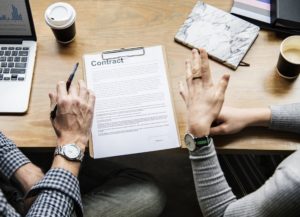 After considering your videos, services, products and pricing, or a free trial, a decision will be made: to buy from you or someone else. To make customer decisions easier, offer several different packages at a variety of price points.
After considering your videos, services, products and pricing, or a free trial, a decision will be made: to buy from you or someone else. To make customer decisions easier, offer several different packages at a variety of price points.
Package 1 might include five important things at your lowest price option. A second Package could include eight important and valuable items at a middle price range. A 3rd Package offer might be all inclusive of what you offer at your highest price point.
Some small online businesses also throw in a few bonus items with each of the packages. These might be checklists, reports, e-books, or even a reformatted useful blog post related to what you are selling.
Finalizing Your Customer Buying Journey
You have been part of their research. They visited your website, worked their way through the Awareness, Consideration and Decision stages and now are ready to buy. Is all of your content clear, concise, accurate – and honest? Does your offering, whether a product or a service, have value for them? Will your offering(s) be the best solutions for their problem or challenges?
They have seen and read Testimonials from satisfied customers, clicked through to a detailed sales/landing page to clinch the deal. This would be a sort of ‘buy-now’ page personalized with their first name. It should identify pain points they face and benefits you offer that exceed those of competitors. And, of course, a button ‘Buy Now!’ button that links them to your Checkout page.
Any customer that makes it through your well laid plans for reaching out and engaging them, then convincing them you ARE what, or who, they need is ready to buy. Somehow at this point, you may need to make a personal contact with them to close the deal. Do they have any questions that still need answers? Maybe a Q&A page on your site, a download or personalized email is in order. Or, a free fifteen or twenty minute phone call via an online conference call service like Zoom or one of these other services in this FitSmallBusiness.com article (face to face via the Internet) could be the final step.
Formulate Your Customer Buying Journey One Stage at a Time
The old-style, cookie-cutter sales funnel isn’t going to be effective today. Remember them? Close your eyes and picture a typical kitchen funnel – large at the top and very narrow at the bottom. You attract a large number of prospects at the top of the funnel. They jump in, then, you try to force them down through the narrow opening at the bottom. Those who make it through the journey are supposed to be your buyers. But, it’s not all that simple. It takes strategic maneuvering to guide them from the top of your funnel (or the 1st Stage) through several well-planned stages. Appropriate content is necessary for each phase of your buyer’s journey. The end result of your campaign to take the masses and sort them down to the most interested will involve:
- Get to know your audience
- Build a Know-Like-Trust relationship
- Uncover and understand their pain points and challenges
- Develop a specific sales funnel relevant to your ideal customers
- Develop a content marketing strategy, including each stage of the buyer’s journey.
- Offer appropriate content for each stage of the buying process.
Wrap up
A successful sales process is not based on a shotgun approach. It takes planning and understanding potential customers and which stage of their buying journey are they in. Think about your offerings and what customers can gain from them. Create appropriate content for your website and other marketing approaches that will be a fit for each stage of the customer buying process. Guide them through the process by having information and answers to questions they have at each stage. Whether you set up a three-, four-, five- or more step Customer Buying Journey process, appropriate information and messaging systems need to be set up. Of course, it takes time and work, but once completed, your site will automate your sales and marketing system. Those systems will do all the work for you, over and over again in the future. Keep it all simple, but effective.
